Did you know birds can eat up to 50% of new grass seed? This fact shows how much birds can affect your lawn. As gardeners, we need to protect our lawns from these birds. In this guide, we’ll show you how to keep birds away from your grass seed. This way, your lawn will stay lush and healthy for a long time.
Key Takeaways
- Birds are a common challenge for newly seeded lawns, consuming up to 50% of grass seed
- Understanding bird behavior and identification of target species is crucial for effective deterrence
- Implementing a combination of physical barriers, visual deterrents, and alternative feeding strategies can help protect grass seed
- Timing the application of protective measures is essential to safeguard the seed during its most vulnerable stages
- Utilizing natural and eco-friendly methods can provide a long-term solution without harming birds or the environment
Understanding Bird Behavior on Lawns
Lawns attract many bird species, making it hard for homeowners to bird-proof grass seeding. Knowing how birds behave in your lawn is key to safeguarding grass seeds. This helps keep your lawn lush and healthy.
Why Birds Are Attracted to Your Lawn
Grass seeds are a tasty and easy meal for birds like sparrows, finches, doves, and crows. These birds love the seeds’ high energy and protein. They can quickly empty a newly seeded lawn.
Common Bird Species That Target Grass Seeds
- Sparrows: These small birds can quickly deplete a seedbed, making them a formidable threat to bird-proof grass seeding efforts.
- Goldfinches: Known for their fondness for grass and flower seeds, goldfinches often forage for buried seeds in the soil.
- Doves: These ground-feeding birds scour the lawn for scattered grass seeds, adding to the challenge of safeguarding grass seeds.
- Crows: Intelligent and adaptable, crows can cause significant disruption to newly seeded areas.
Signs of Bird Activity in Your Garden
Watching your lawn closely helps spot bird problems. Look for small holes in the soil, seed leftovers, and birds eating on the ground.
“Grass seeds provide high nutrition and energy, making them a prime target for many bird species. Newly planted areas often retain moisture, further enhancing their appeal to foraging birds.”
Understanding bird habits helps homeowners protect their grass seeds. This way, they can grow a lush, bird-proof lawn.
The Impact of Birds on Newly Seeded Lawns
Birds can be good for controlling insects and keeping the ecosystem healthy. But, they can be a big problem for new lawns. Studies show birds mostly eat other foods, not grass seed. Yet, some birds might eat grass seed, especially if it’s small.
This can mess up the grass seed’s chance to grow. It can cause bare spots and an ugly lawn. Homeowners work hard to get a beautiful lawn, but birds can ruin it.
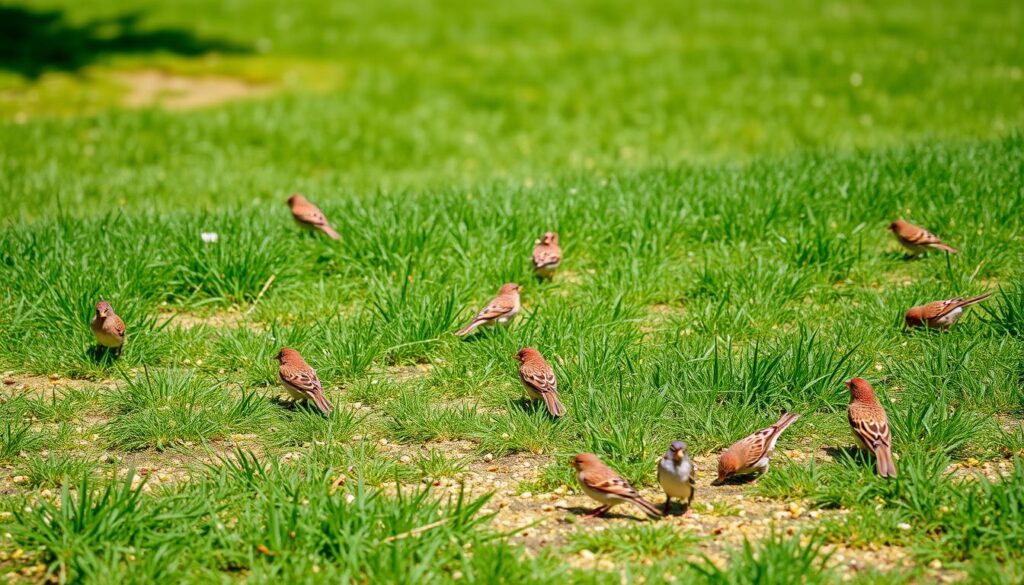
To stop birds from eating seeds, you need to seed right. This means preparing the soil well and choosing the right seeds. You can also use things like netting or scarecrows to keep birds away.
Using safe sprays to scare birds off is another option. You could also try planting different types of plants that birds don’t like.
When you seed your lawn, timing is key. Spring and fall are the best times for seeds to grow. Taking care of your lawn by watering, mowing, and fertilizing helps keep birds away.
How to prevent birds from eating grass seed?
Keeping birds away from your grass seed is key to a beautiful lawn. Timing is crucial for effective prevention. Start protecting your seed right after you plant it.
Identifying the Right Time to Apply Protection
Birds love fresh grass seeds because they’re easy to eat. Acting fast helps keep birds away and lets your seed grow well. The first few weeks are the most important for keeping birds off.
Essential Prevention Planning
- Know your lawn size and the birds in your area to plan well.
- Use a mix of methods to keep birds away, as they can get used to one thing.
- Watch your lawn often, as bird activity changes with the seasons.
To keep birds from eating your grass seed, you need a solid plan. A good strategy will protect your investment and make your lawn look great.
Physical Barriers: Netting and Burlap Solutions
To keep birds away from your new lawn, you need a good plan. Netting and burlap sheets are two effective barriers. They let water and sunlight in but keep birds out.
Lightweight netting hung a few inches above the soil works well. It blocks birds from getting to the bird-proof grass seeding. It’s simple to set up and covers a lot of ground, making sure all seeds are safe. After the seeds grow, you can take down the netting.
Burlap fabric is another good option. It covers the seeds, keeping birds away. It’s great for smaller areas. But, burlap can be more expensive for big lawns.
It’s important to put up and take down the barriers at the right time. Keep them on until the seeds grow, usually 2-4 weeks. Taking them off too soon lets birds eat the seeds. Leaving them on too long can slow down seedling growth.
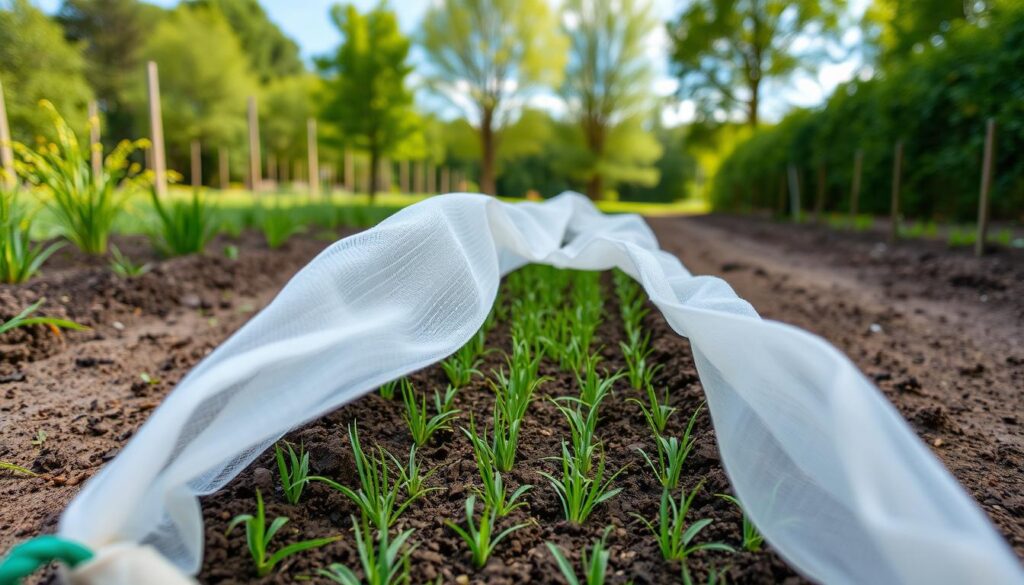
Using these barriers can help protect your bird-proof grass seeding. You’ll get a beautiful, healthy lawn even with birds around.
Using Mulch and Straw Coverage Techniques
Keeping your grass seed safe from birds is key for a great lawn. Mulch or straw can act as a natural shield. They hide the grass seed from birds that like to eat it.
Types of Protective Mulch
Choosing the right mulch is important for grass seed protection. Go for weed-free options like straw, wood chips, or pine needles. These materials won’t harm your lawn as it grows.
Proper Application Methods
- Spread a thin layer of mulch, about 1/4 to 1/2 inch, over the seeds.
- Don’t use too much mulch to avoid blocking the seeds from germinating.
- Apply the mulch gently so the seeds stay in touch with the soil.
Timing of Removal
When the grass seed starts to grow, start removing the mulch. Do this slowly over weeks. This lets the seeds get enough light and grow well.
“Using mulch or a thin layer of soil can hide grass seeds from birds, helping to prevent them from eating them.”
Using these grass seed protection and bird repellents for lawns methods helps keep birds away. This creates a perfect environment for a lush, healthy lawn.
Visual Deterrents and Reflective Objects
Keeping birds away from your lawn can be tough. But using visual deterrents and reflective objects helps a lot. These methods make the area look so different that birds don’t want to land or eat the grass seed.
Reflective items like shiny CDs, aluminum foil, or bird deterrent tape are great. They reflect sunlight and dazzle birds, making them leave the area. Placing these items around your lawn can really cut down on bird visits.
Bright flags and wind chimes are also good at keeping birds away. Their movement and colors make the area seem unstable. This makes birds less likely to come near. Putting these items in key spots around your lawn adds extra protection.
It’s important to place these deterrents well. Using different heights and angles makes the area harder for birds to navigate. This way, you cover more ground and keep birds from finding places to land.
Keep in mind, these deterrents work best when they’re new and changing. Moving or rotating them often keeps birds guessing. This keeps them from getting used to the setup.
By using visual deterrents and reflective objects, you can make your lawn less appealing to birds. This helps your grass seed grow strong and healthy.
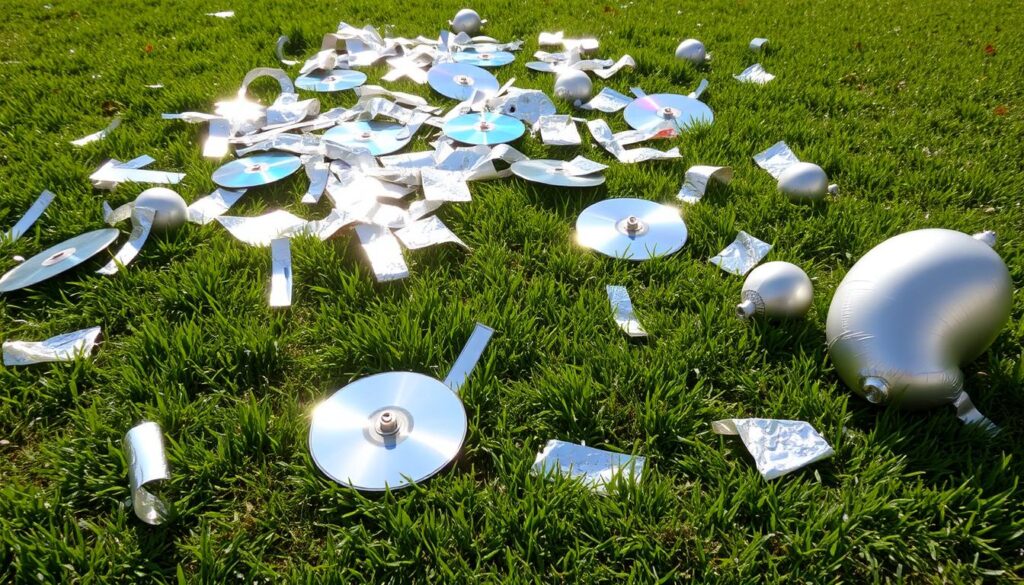
Motion-Activated Sprinkler Systems
Keeping birds away from new grass can be tough. But motion-activated sprinkler systems are a great, safe way to do it. They scare birds with sudden water bursts, making them fly away fast.
Installation Tips
It’s important to place motion-activated sprinklers right to cover the whole seeded area. They have adjustable settings for sensitivity and spray patterns. This lets you tailor the coverage to fit your lawn’s needs.
Some models, like the Yard Enforcer from Orbit, can even be programmed. They shoot water bursts directly at birds, making them more effective.
Coverage Areas and Effectiveness
Motion-activated sprinklers, like the Solar Sprinkler, don’t need electricity. This makes them great for lawns and gardens. The Yardeen Garden Water Motion Sprinkler lets you adjust its range for better coverage.
Using more than one sprinkler can also help cover more ground. This makes the system more effective at keeping birds away.
Reese L Robbins from Just Pure Gardening says these sprinklers work well. They scare off birds, dogs, deer, and mice from damaging your lawn. The sudden water startles them, making them leave the area.
These systems can be set to work when birds are most active. This makes them even better at protecting your new grass from birds. With many options out there, motion-activated sprinklers are a reliable, safe choice for bird control.
Bird-Repellent Sprays and Solutions
Protecting your lawn from birds can be done with bird-repellent sprays. These sprays have ingredients like aluminum ammonium sulfate. They make birds taste and smell something bad without harming them or your grass seed.
To use these sprays right, read the instructions carefully. Spread the solution all over the seeded area. Make sure it covers everything well. After rain or watering, put it on again to keep birds away.
Research shows that 80% of bird repellent methods use fear to keep birds off. But, sprays with Aluminum Ammonium Sulphate are safe for birds. They work well to stop birds from eating grass seeds.
Another cool idea is coated grass seeds with a bird-repellent coating. These seeds taste bad to birds, keeping them away without hurting them. Adding these seeds to your lawn care can be very helpful.
“Liquid bird repellent sprays need to be reapplied every few days to ensure a heavy coating that irritates birds and conditions them to stay away during the early stages of the process.”
When picking a bird-repellent spray, look for ones like Avian Control Bird Repellent Spray. It covers 3-5 acres with just one gallon. Make sure to apply and reapply it well to keep birds away.
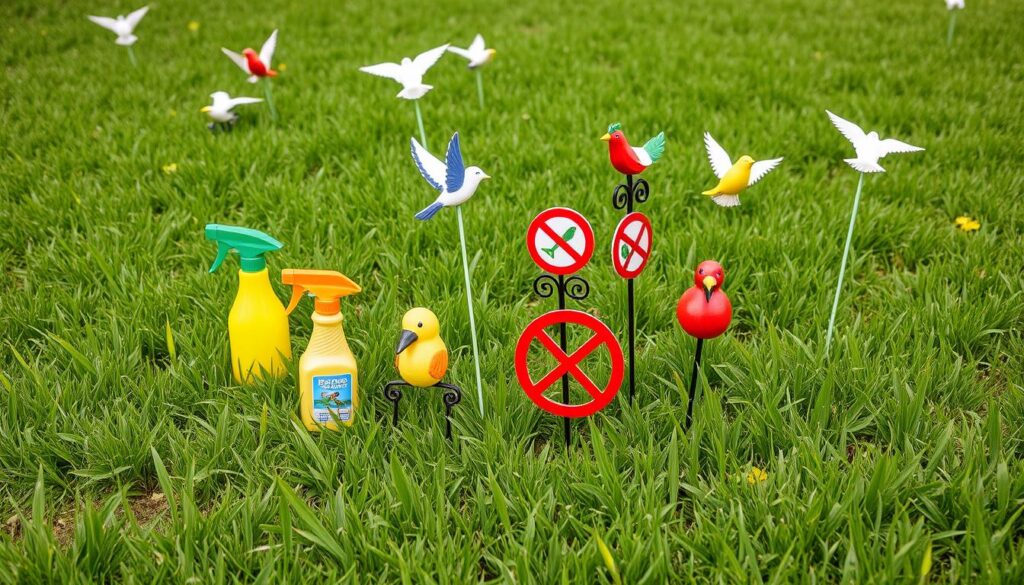
Using bird-repellent sprays in your lawn care can really help. It can lessen the damage birds do to your new grass. This way, you can grow a beautiful, green lawn.
Alternative Feeding Stations
Keeping birds away from your new lawn can be tough. But, setting up bird feeders elsewhere can help. This way, birds have food without eating your grass seeds.
Strategic Placement of Bird Feeders
Put bird feeders far from your lawn. Studies say this can cut down on seed eating by up to 70%. Make sure feeders are at least 12 feet from bushes or trees. This keeps birds safe and focused on their food.
Recommended Feed Types
- Black oil sunflower seeds: These high-energy seeds are a favorite among a variety of bird species and can help keep them satisfied and away from your grass seed.
- Millet: This small, round grain is a popular choice for ground-feeding birds, making it an excellent alternative to your newly seeded lawn.
- Cracked corn: Offering cracked corn can attract a diverse range of birds, including sparrows, doves, and even some larger species, keeping them occupied away from your grass seed.
By offering these food options, you can keep birds away from your grass seed. This helps safeguard the health and growth of your lawn.
Natural Bird Deterrent Methods
Protecting your lawn from birds can be done naturally and eco-friendly. These methods keep birds away and support your bird-proof seeding plan.
Planting bird-repelling plants around your lawn is a good start. Lavender, marigolds, and geraniums can scare birds off with their smells. You can also make a homemade bird repellent spray with peppermint oil or weak black tea. Spray it on your grass seed.
- Plant bird-repelling herbs and flowers like lavender, marigolds, and geraniums
- Mix a homemade spray using peppermint oil or weak black tea to deter birds
These natural methods keep birds away and improve your lawn. They also make your garden look better and healthier. Using these eco-friendly methods helps create a safe space for your grass while keeping your garden sustainable.
“Combining natural deterrents with other bird-proofing strategies can effectively protect your grass seed investment and create a thriving, lush lawn.”
For the best bird deterrence, mix different methods. Use physical barriers, visual deterrents, and alternative feeding stations. This multi-faceted approach ensures your effective bird deterrence methods and bird-proof grass seeding succeed.
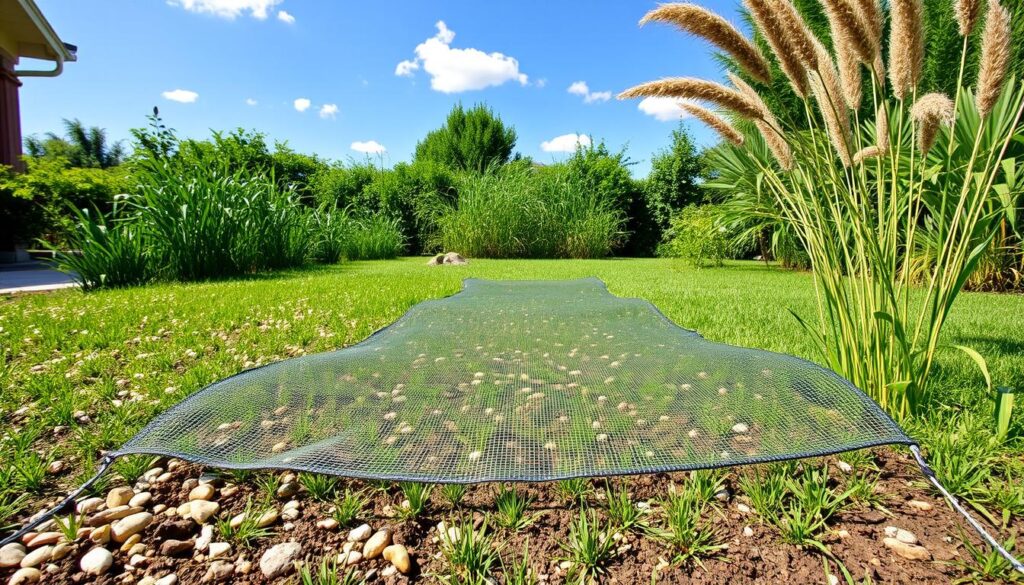
Using Decoy Predators
One effective way to keep birds away from your new lawn is by using decoy predators. These models, like plastic owls or hawks, look real and scare birds. They pretend to be the birds’ natural enemies.
Types of Effective Decoys
It’s key to pick decoy predators that look real. Some have motion sensors or sound effects to make them more convincing. Moving decoys are better at scaring birds than still ones.
Optimal Placement Strategies
To keep decoy predators working, move them often. Birds get used to still decoys quickly. So, change their spot every few days or weeks. Place them in open, visible spots on your lawn.
Decoy predators are just one part of keeping your lawn safe from birds. Use them with other methods like netting or motion-activated sprinklers. This way, you can protect your new grass well.
| Decoy Type | Effectiveness | Pros | Cons |
|---|---|---|---|
| Plastic Owl | High | Realistic appearance, can be motion-activated | Birds may become accustomed to static decoys |
| Rubber Snake | Moderate | Inexpensive, can be positioned in different areas | Less realistic than other predator decoys |
| Hawk Silhouette | High | Easily visible, can be mounted on a pole or tree | May require more frequent repositioning |
By using decoy predators smartly, you can bird control for new grass effectively. This helps keep your lawn lush and healthy.
Sound-Based Deterrent Systems
Sound-based systems are great for keeping birds away from your grass seed. They use sounds that birds find scary or unpleasant. This makes your lawn less appealing to them.
Electronic devices that make ultrasonic sounds are popular. These high-pitched sounds bother birds and make them leave. Placing these devices around your lawn keeps birds out.
Predator calls or bird distress signals also work well. They sound like real predators or birds in trouble. This scares birds away. Adding visual decoys makes it even more effective.
But, sound-based deterrents might disturb neighbors or pets. It’s key to pick devices that are effective but don’t bother others too much.
“Incorporating sound-based deterrents as part of a comprehensive bird management strategy can be a highly effective way to protect your lawn’s grass seed from avian intruders.”
Knowing how sound-based systems work helps you choose the right one. This ensures your lawn stays bird-free and healthy.
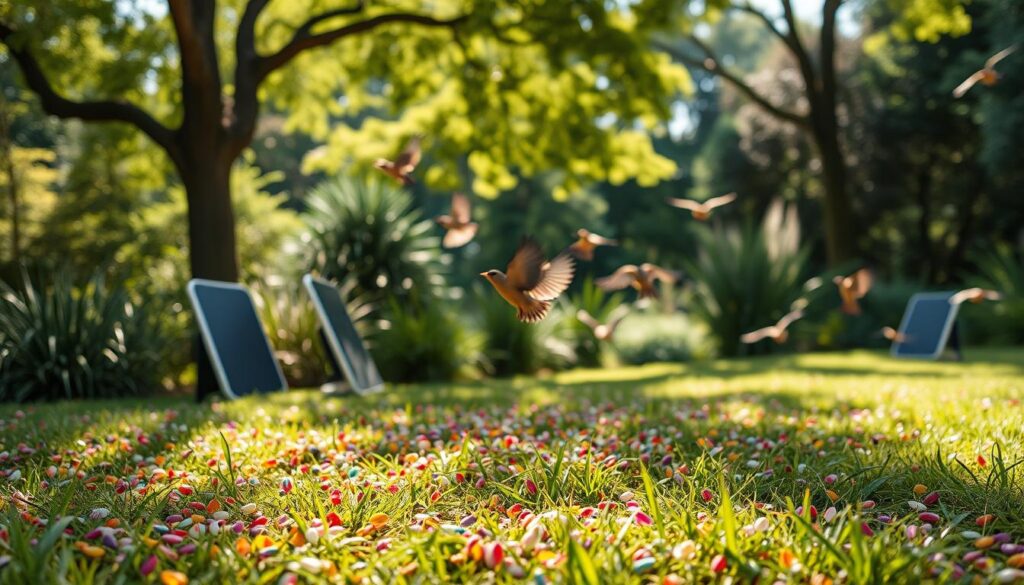
| Product | Features | Coverage Area |
|---|---|---|
| Bird B Gone’s Bird Repellent Sound Systems | Targets a wide range of pest bird problems in different venues: commercial, industrial, municipal, and residential. | – |
| Bird Chase Super Sonic base unit | Emits ultrasonic frequencies and predator calls to deter birds. | Up to 1 acre |
| Solar Bird Chase Super Sonic | Features ultrasonic frequencies, predator calls, and is solar-powered. | Up to 1 acre |
| Sonic Shield™ Bird and Critter Deterrent | Uses flashing LED lights and loud barking dog sounds to scare critters away. Works in daytime and nighttime modes. | – |
Special Seeds and Treatments
Protecting your lawn from birds can be done with special seeds and treatments. These products help keep birds away without harming your lawn. Coated seeds with bird-repellent properties are very effective. They keep birds off while letting the seeds grow into a healthy lawn.
Rapid-absorption seeds germinate fast, making your lawn less appealing to birds. This quick growth helps your lawn seeding project succeed. It ensures your hard work is not ruined by birds.
Using bird-proof grass seeding techniques can make your lawn lush and vibrant. It also reduces the impact of birds on your seed investment. These solutions offer a smart way to protect your lawn, fitting your specific gardening needs.
FAQ
How can I prevent birds from eating my newly seeded lawn?
To keep birds away from your seeds, use netting or burlap. You can also apply mulch or straw. Motion-activated sprinklers and bird-repellent sprays work well too. Providing alternative food sources and using decoy predators are other options.
What are the common bird species that target grass seeds?
Birds like sparrows, finches, pigeons, and blackbirds love grass seeds. They’re attracted to the seeds, worms, and insects in the lawn.
What are the signs of bird activity in my garden?
Look for small holes in the soil and seed consumption. Birds foraging or nesting in your lawn are also signs. Spotting these signs early helps you act fast.
How does bird activity impact a newly seeded lawn?
Birds eating seeds before they germinate can damage your lawn. This leads to uneven growth and bare spots. While birds control insects, too much activity can harm your lawn’s health.
When should I apply bird deterrent measures on my lawn?
Start protecting your seeds right after you sow them. This shields the seeds from birds during the critical germination period. It helps your lawn grow well.
What are the essential planning considerations when protecting grass seed from birds?
Think about your lawn’s size, the birds in your area, and what you have available. Using a mix of methods is usually more effective than one approach.
How do netting and burlap sheets help protect grass seed?
Netting and burlap sheets block birds from getting to the seeds. They let water, sunlight, and air through. Remove them once the seeds start growing.
How can mulch and straw help safeguard grass seed?
Use a thin layer of straw mulch or biodegradable materials after sowing. Make sure it’s weed-free. Remove it as the grass grows to let it get enough light.
What types of visual deterrents and reflective objects can I use?
CDs, aluminum foil strips, or bird tape can scare birds with their reflections. Bright flags and wind chimes also help keep them away.
How do motion-activated sprinkler systems work to keep birds away?
These systems spray water when birds move nearby. This startles them and keeps them from your lawn. You can cover your whole lawn with them and adjust their sensitivity.
What are the benefits of using bird-repellent sprays?
These sprays have non-toxic ingredients that birds don’t like. They won’t harm your grass or the birds. Reapply them after rain to keep them working.
How can providing alternative feeding stations help protect my grass seed?
Put bird feeders elsewhere and offer different food like sunflower seeds or cracked corn. This diverts birds from your lawn. It’s a good addition to other bird control methods.
What are some natural deterrent methods I can use?
Planting certain plants or using homemade sprays with peppermint oil can help. These eco-friendly options work well with other methods.
How can decoy predators help keep birds away?
Plastic owls, hawks, or rubber snakes can scare birds. Move them often to keep them effective. Some models have sounds or motion sensors.
What sound-based deterrent systems can I use?
Sound systems that mimic predators or distress calls can scare birds. Ultrasonic devices also work, but consider their impact on neighbors and pets.
Are there any special seeds or treatments that can help protect against bird damage?
Yes, there are seeds coated with bird-repellents or that germinate quickly. These reduce bird damage and help your lawn grow well.
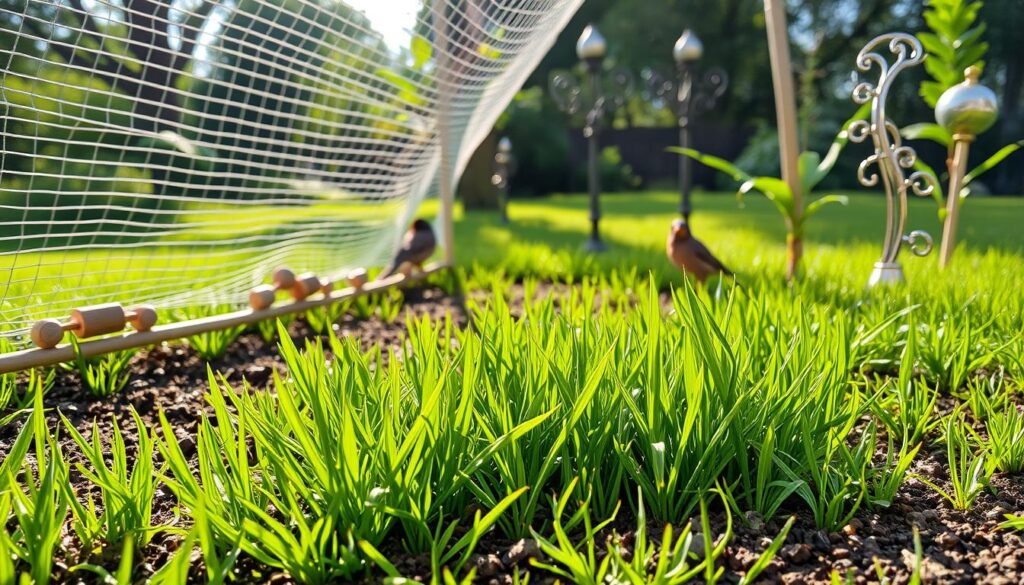

Muchas gracias. ?Como puedo iniciar sesion?